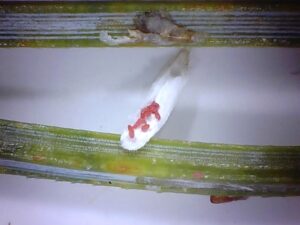Dormant Oil Guidelines:
Dormant oils at 2-4% rates in the late fall & late winter seasons can aid in the control of overwintering insects and insect eggs. Consider treating for such pests as aphids (eggs), southern red mites/eggs, spruce spider mites/eggs, oak spider mites (eggs), eriophyid mites/eggs, spruce gall adelgids, lace bugs (deciduous plants), cankerworms (eggs), leaftiers, psyllids, plant bugs, etc.
Some landscapers have been successful applying both late fall and early spring dormant oil treatments to the same plants on the same properties. This is a reasonable approach since a single dormant oil treatment will not provide 100% control and it gives the field technician another opportunity to monitor the landscape for problems.

Dormant oil sprays require excellent coverage & often repeat applications. (Photo Credit: Steven K. Rettke, Rutgers Coop. Ext.)
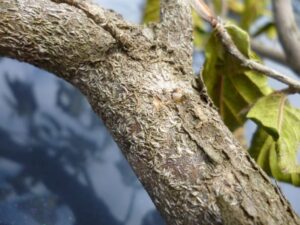
Japanese maple scale infested branch will likely require multiple dormant oil treatments to suppress. (Photo Credit: Steven K. Rettke, Rutgers Coop. Ext.)
Before applying dormant oils, monitor the plant to be sure of the susceptible life stage and location of the pest. Properly direct the spray to where the pest is located on the plant (underside of foliage, bark, leaf buds, etc.). For best results apply your dormant oil sprays to targeted areas that have been scouted for pests. Avoid the common tendency of applying blanket dormant oil treatments to large block areas that may only possibly contain susceptible pests. Blind, blanket sprays of dormant oils will unlikely achieve adequate coverage & will not provide satisfactory controls. Such practices are irresponsible, especially in areas were there is no target pest. Remember, when applying pesticides (including dormant oils): “A prescription without diagnosis is malpractice” & “look before you shoot.”
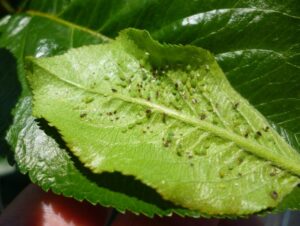
Active aphids do not overwinter & will not be targeted with dormant oil sprays. (Photo Credit: Steven K. Rettke, Rutgers Coop. Ext.)
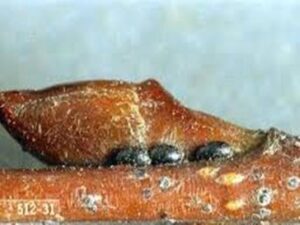
Overwintering aphid eggs are typically black & laid in cryptic areas such as near leaf buds. (Photo Credit: Ohio State Coop. Ext.)
Nevertheless, dormant oil controls have some limitations. It is important to note that late winter or early spring dormant oils may often provide superior results and possibly with better plant safety. Generally, dormant oil applicators need to remember that their treatments rarely give 100% control, and in some situations may provide poor results against difficult to control targeted pests.

Elongate hemlock scales are exceptionally difficult to control with dormant oils. (Photo Credit: Steven K. Rettke, Rutgers Coop. Ext.)
Phytotoxicity Concerns:
Dormant oils are typically applied when temperatures will remain above 40°F. for 24 hours. However, several University studies determined that no phytotoxicity occurred at lower temperature applications. If sprays are applied just prior to temperatures dropping below freezing, the emulsion breaks down, causing the oil to adhere to the bark/leaves instead of the targeted insect stage.
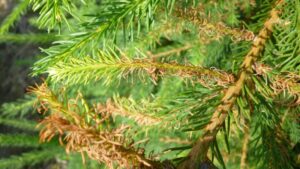
Phytotoxicity of frasier fir from an improper oil spray treatment. (Photo Credit: Steven K. Rettke, Rutgers Coop. Ext.)
However, certain plants will be detrimentally affected regardless of temperature. Plants that have a blue glaucous bloom on foliage, such as the blue spruces and blue junipers, will have the waxy bloom removed. However, the untreated new spring growth will develop the blue color and the bloom should eventually return on the older, treated needles within a season. However, the glaucous bloom does apparently provide some protection against winter injuries. In general, plants having hairy leaves are more sensitive since they retain the oil for a longer amount of time. Hence, these plants should be treated with a lower concentration.

Waxy, blue glaucous bloom removed from Colorado Blue Spruce by unwise dormant oil sprays. (Photo Credit: Steven K. Rettke, Rutgers Coop. Ext.)
When mixing, add water to the tank first, and then add the oil. The mixture should look like skim milk. Constant agitation is necessary during application (do not apply if the solution has been sitting 10 minutes or more without agitation). Finally, if the target pest is located on a plant that has experienced a good deal of environmental stress, then wait until the early spring for treatment reassessment.
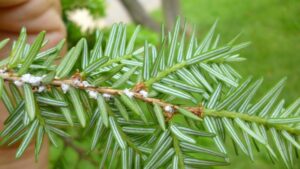
Do not apply oil sprays against hemlock woolly adelgids if the hemlock tree is under environmental stress. (Photo Credit: Steven K. Rettke, Rutgers Coop. Ext.)
Dormant Oils and Spider Mite Controls:
During the months of autumn, many landscape managers begin applying horticultural oils (2-3%) to suppress spider mites. Spruce spider mites and southern red spider mites are the two primary species that are active on landscape plantings during the fall season. The spruce spider mite feeds primarily on conifers, while the southern red spider mite feeds primarily on broadleaf evergreens. Both species have building populations during the fall months and typically reach peak levels during the month of November. These cool season mites have 3 or 4 generations during the fall period. By December, they conclude the laying of overwintering eggs.
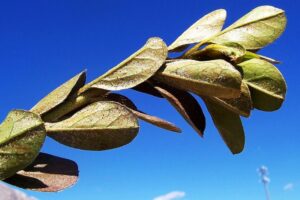
Southern red spider mites lay bright red eggs beneath leaves of broadleaf evergreens. (Photo Credit: Steven K. Rettke, Rutgers Coop. Ext.)

Spruce spider mites lay overwintering eggs at the terminals of conifer twigs, (Photo Credit: Ohio State Coop. Ext.)
Symptoms from autumn mite feedings often do not become evident until the following spring or summer. The application of horticultural oil in the fall can be important to prevent unacceptable damage. Dormant oil sprays will suppress mite adults, immatures, and eggs. Remember that oils have a physical mode of action and cause a disruption of cell membranes (indirectly promotes suffocation). Therefore, to be effective, thorough oil coverage is required.
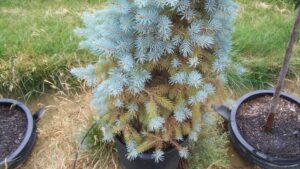
Of course, oils should not be applied against the spruce spider mites infesting this blue spruce. (Photo Credit: Steven K. Rettke, Rutgers Coop. Ext.)
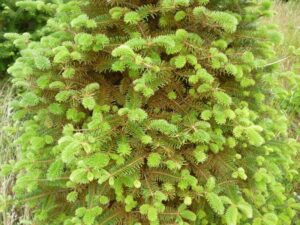
Frasier fir in summer showing spruce spider mite damage from previous fall/spring feedings. (Photo Credit: Steven K. Rettke, Rutgers Ext.)
As a further reminder, do not make the mistake of applying oil sprays to kill “overwintering eggs” of two-spotted spider mites (e.g., burning bush). This warm season spider mite species does not overwinter as eggs, but rather as adults. The female adults are hidden in protected areas under the plants (e.g., soil/mulch) where oils cannot effectively contact them. Oil applications this time of year will be a waste of time and material. Controls will have to wait until next year when they emerge during the late spring/early summer months.
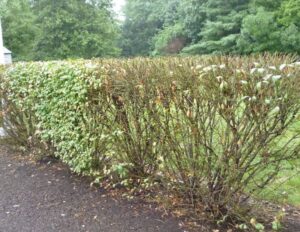
Do not apply dormant oils against overwintering two-spotted spider mites on burning bush. (Photo Credit: Steven K. Rettke, Rutgers Coop. Ext.)
Dormant Oils and Armored Scale Controls:
Euonymus, Elongate Hemlock, Pine Needle, Juniper, White Prunicola, Pine Oystershell, Obscure, and Oystershell are all examples of armored scales that should be monitored during the fall and winter. Look for the elongate or circular shapes and the typically white or grayish colored scale covers of overwintering adult females on twigs, branches, or trunks. Dormant oil sprays are more effective against soft scale species than against armored scale species. Some armored scale suppression may occur, but satisfactory results are not always achieved. Numerous studies indicate the level of armored scale suppression with a single dormant oil treatment may reach less than 30%. When infestations are extremely high, the scale populations may be lightly brushed off the trunk and branches, or simply pruned out.
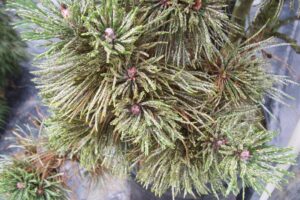
Pine needle scale showing extreme infestations will require multiple sprays. (Photo Credit: Steven K. Rettke, Rutgers Coop. Ext.)
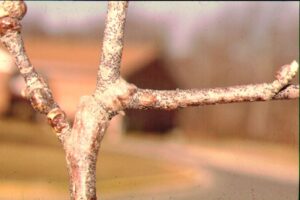
Alternatively, a single dormant oil spray will achieve excellent results against most soft scales, such as these overwintering 2nd instar tuliptree scales. (Photo Credit: Steven K. Rettke, Rutgers Coop. Ext.)
Live vs. Dead Scale Characteristics:
Probably all too often, oil treatments are applied to scale populations that are not viable. Just a little bit of extra time is required to determine if the observed scales are dead or alive.
Compare a live, viable scale insect to a water filled balloon. If the cover is somewhat flexible and soft to the touch it may still be alive. Furthermore, with the use of a sharp pinpoint (e.g., insect mounting pin), determine if insect body fluids are released. When the waxy cover of a live armored scale is removed from the plant surface, it will often appear as a red/yellow “blob of jelly.”
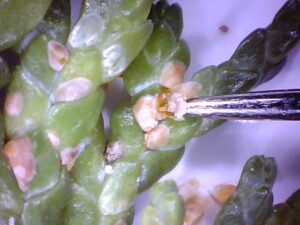
Testing for the viability of these juniper scales. Punctured scale shows body fluids. (Photo Credit: Steven K. Rettke, Rutgers Coop. Ext.)

Removed cover of a juniper scale shows the “yellow blob” of the actual insect. (Photo Credit: Steven K. Rettke, Rutgers Coop. Ext.)
By mid to late winter, uncovering pine needle scales will show red colored eggs and dead adult females (i.e., the female scale becomes darkened, dry, and shrunken in appearance). Pine needle scale eggs will hatch, and red colored crawlers of the 1st generation will emerge some time in May.
